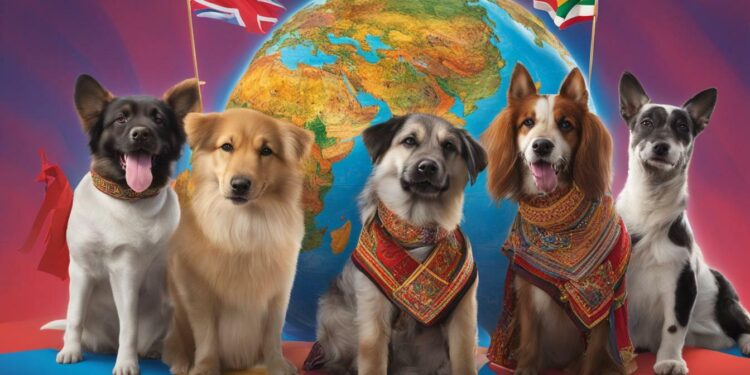Cultural Canines: Dogs’ Enduring Impact Worldwide

Cultural Significance Of Dogs Worldwide: Dogs are important in many cultures across history. They are often depicted in art as symbols of guidance, protection, loyalty, and love. Ancient Greeks, Romans, and people from the Middle Ages viewed dogs as faithful companions and exchanged them as gifts. Dogs’ keen senses and instincts made them useful in war and hunting. In the Middle Ages, they were symbols of faith and loyalty and shown in portraits with noble figures. Heraldry saw dogs as symbols of courage, vigilance, loyalty, and fidelity, representing noble qualities. Dogs have even been associated with divinity and spirituality in various cultural contexts, emphasizing their cultural significance.
Dogs are important in many cultures and are loved as family. Humans have loved pets for a long time and have emotional connections with them. Dogs have always been special to people and are still loved today. People treat pets differently in different cultures, but everyone cares for them. Dogs have played important roles in history and are cherished as family members all over the world.
Dogs as Symbols in Art

Numerous civilizations depict dogs as symbols of strength and devotion. These illustrations show how dogs have influenced culture throughout history. Artists have often shown dogs as loyal friends and reliable partners.
Ancient Egyptian art often depicted dogs with pharaohs and gods. These depictions highlighted the dog’s afterlife guardianship and guidance. Renaissance painters loved dogs because they symbolized the human-canine bond.
Dogs, indicating their vital role in assisting people hunt, have often figured in hunting portrayals throughout history. These texts praise dogs for their loyalty, speed, and hunting abilities. Their presence here symbolizes their cultural relevance in many communities.
| Symbol | Description |
|---|---|
| Guidance | Dogs are often portrayed as guides, leading humans to safety or showing them the right path. |
| Protection | Dogs symbolize protection, safeguarding their owners from harm and danger. |
| Loyalty | Dogs are often associated with loyalty, demonstrating unwavering devotion to their human companions. |
| Affection | Artworks frequently depict dogs as symbols of love and affection, showcasing the emotional connection between humans and their pets. |
These artworks demonstrate the cultural significance of dogs in numerous cultures and the tremendous respect people have always had for these faithful and loving friends.
Dogs in Ancient Greece and Rome
Native American rituals included dogs. The Native Americans respected dogs for connecting the living and the dead. They were believed to guide wandering souls, protect them from evil spirits, and provide wealth. Navajo spirituality led them to use dogs for healing and travel.
The past and indigenous peoples don’t influence humans’ spiritual connection with dogs. In modern Buddhism, dogs represent loyalty, compassion, and selflessness. Everyone is reminded of virtues to improve. Animal-assisted therapy uses dogs as spiritual guides to heal emotional scars and complete spirituality.
Old Greek and Roman aristocracy valued dogs beyond their utility. They appeared in status symbol photos with their aristocratic owners. These depictions portrayed people and dogs’ emotional bond.
Dogs were culturally significant beyond friendship. Dogs worshipped Artemis in ancient Greece. They represented loyalty and protection like Artemis. In Rome, owners and dogs were buried together to honor their relationship.
| Key Points |
|---|
| Dogs were revered as faithful companions in ancient Greece and Rome. |
| They were depicted in art as symbols of loyalty, guidance, and protection. |
| Dogs were highly valued by the upper classes and were seen as status symbols. |
| In ancient Greece, dogs were associated with the goddess Artemis and were considered sacred. |
| In Rome, dogs were often buried with their owners, showcasing their importance and the bond they shared. |
Dogs in War and Hunting
Dogs have been valued for their combat and hunting skills in numerous civilizations. Due to their intellect, loyalty, and instincts, dogs have been trained for thousands of years in these jobs. They are inseparable pals and strategic assets due to their warfare and hunting skills.
War
Dogs have long been military messengers, sentries, and scouts. Their speed and sharp senses allow them to track opponents, uncover hidden treasures, and warn trainers of danger. They are armed and trained to deter and assist soldiers. Military soldiers respect dogs for their loyalty and steadiness.
Hunting
Hunters have also used dogs, with some breeds better at certain game species. Their keen senses and quick reactions aid search-and-rescue missions. Hunters have greatly benefited from dogs’ inherent senses and odor-following abilities.
| Country | War | Hunting |
|---|---|---|
| Ancient Greece | Dogs accompanied soldiers in battle, offering protection and companionship. | Various breeds were used in hunting, including greyhounds for hare coursing. |
| Medieval Europe | War dogs were trained for combat, with mastiffs used as guard dogs for castles. | Dogs were utilized for hunting deer, boar, and small game. |
| China | Dogs were employed for warfare, particularly during the Tang Dynasty. | Various breeds, such as the Chow Chow, were used for hunting and protection. |
The diverse roles that dogs have played in war and hunting reflect their cultural significance and the valued contributions they have made to societies throughout history. Their loyalty, intelligence, and natural abilities have earned them a place of honor and admiration in various countries and continue to do so in present times.
Dogs in the Middle Ages
During the Middle Ages, dogs held a prominent place as symbols of faith, loyalty, and steadfast protection. In this era, dogs were highly regarded and often depicted in portraits, tapestries, and other forms of art. They were seen as companions and were loyal to their masters, making them highly valued members of households.
Heraldry became popular during the Middle Ages, and dogs played a big part in it. These dogs were often shown as brave and watchful, representing the traits that were highly valued. They were featured in coats of arms, shields, and banners, representing the important families they belonged to.
In addition, dogs were commonly used in hunting during this time. They were trained to find and chase game, making them essential companions for hunters. Hunting scenes often showed dogs in action, displaying their speed, agility, and excellent sense of smell.
Overall, dogs in the Middle Ages were not only loyal friends but also symbols of loyalty, protection, and courage. Their depictions in art and their roles in hunting illustrate their significance and cultural importance during this era.
| Key Points |
|---|
| Dogs symbolized faith, loyalty, and steadfast protection in the Middle Ages. |
| Heraldic dogs represented courage, vigilance, loyalty, and fidelity in coats of arms and banners. |
| Dogs were used in hunting and were valued for their tracking and chasing abilities. |
Dogs in Heraldry
In the world of heraldic design, dogs were commonly used as charges, or central figures, in coats of arms. These coats of arms depicted the family lineage and were used to symbolize the qualities and characteristics associated with that family. Dogs, with their innate loyalty and protective nature, were seen as fitting representations of the virtues cherished by these families.
A popular depiction of dogs in heraldry is the greyhound, known for its speed and agility. The greyhound was often used to represent nobility and aristocracy, symbolizing qualities such as courage and nobility of spirit. Other breeds, such as the mastiff or bloodhound, represented strength and fierceness, making them fitting symbols for families who prided themselves on their warrior-like qualities.
| Breed | Meaning |
|---|---|
| Greyhound | Speed, agility, nobility |
| Mastiff | Strength, courage, fierceness |
| Bloodhound | Vigilance, loyalty, keen senses |
These heraldic dogs were often depicted in a regal pose, with their heads held high and their tails raised in a proud manner. They were often portrayed as guardians, watchful and protective of their families. Their inclusion in coats of arms served as a reminder of the family’s heritage and the values they held dear.
Through the art of heraldry, dogs have left an indelible mark on the cultural history of various countries. Their presence in coats of arms not only represented the qualities of loyalty and bravery but also served as a testament to the deep bond between humans and their canine companions.
Dogs as Divine and Spiritual Figures
Canines have always symbolized mystery and holiness. Many ancient cultures believed dogs divine. The jackal head of Anubis symbolizes death and the afterlife. Hinduism venerated dogs for warding off evil spirits and guarding doorways.
Native American religions relied on dogs. Dogs helped Native Americans communicate with the afterlife. They were thought to direct lost souls, defend owners from evil spirits, and bring luck. The Navajo used dogs in rituals and ceremonies as holy companions.
The human-dog spiritual bond is not limited to indigenous cultures or the past. Dogs represent loyalty, compassion, and selflessness in modern religions like Buddhism. They gently encourage character development. Dogs guide patients’ spiritual and psychological healing in animal-assisted therapy.
The Spiritual Significance of Dogs in Different Cultures
Many civilizations revere dogs as spiritual intermediaries or deities. They are valued for their loyalty, keen perception, and ability to form deep emotional ties with humans. Dogs have been companions, protectors, and guides on the spiritual path, offering comfort, solace, and a sense of belonging. The bond between humans and dogs transcends language barriers and cultural differences, reminding us of the universal love and connection that exists between all living beings.
| Country | Belief/Cultural Practice |
|---|---|
| Egypt | Association of dogs with the god Anubis and their role in funerary rituals |
| Hinduism | Worship of dogs as conduits of divine protection and guardians of the home |
| Native American | Belief in the spiritual power of dogs as guides, protectors, and mediators between the human and spiritual realms |
| Buddhism | Symbolic association of dogs with loyalty, compassion, and the pursuit of enlightenment |
As we continue to explore the cultural importance of dogs in various countries, it becomes evident that their spiritual significance transcends time and borders.
Dogs as Family Members
Dogs have found a place as beloved family members, receiving unconditional love and care in various cultures worldwide. Across countries and continents, dogs have become cherished companions, providing emotional support, loyalty, and joy to their human counterparts. They have seamlessly integrated into the fabric of family life, standing as symbols of love and devotion.
Dogs are often seen as a part of the family. They are great companions and bring comfort and security. They make both kids and adults happy with their playful nature. Dogs listen to our problems and offer support without judgment. They provide love and comfort during tough times.
Cultural Attitudes
The cultural attitudes towards dogs as family members vary across different countries. Some cultures prioritize the well-being of dogs, ensuring they receive proper care, nutrition, and medical attention. In these cultures, dogs are often included in family activities and celebrations, and their needs are given equal importance. Other cultures may not view dogs as family members in the same way, but still recognize their value and treat them with kindness and respect.
| Country | Attitude towards Dogs as Family Members |
|---|---|
| United States | Dogs are considered full-fledged members of the family, often referred to as “fur babies” and included in family events and celebrations. They are provided with high-quality food, regular veterinary care, and personalized accessories such as clothing and toys. |
| Japan | Dogs are valued as family members in Japanese culture, with many households considering them as important as human relatives. Dogs are pampered with special treats, clothing, and grooming services. |
| India | In India, dogs are recognized as loyal and protective companions. While they may not always be considered formal family members, they are treated with kindness and provided with food, shelter, and care. |
People appreciate dogs as family regardless of culture. The love and compassion between humans and dogs transcends boundaries. Dogs are loved by families worldwide for cuddling on the couch, playing fetch in the park, or listening.
Global Phenomenon of Pet Ownership
Pet love and friendship have transcended cultural divides and united people worldwide. Many countries value pet ownership, especially dogs. About 57% of families worldwide have a pet, with dogs being the most popular.
Human-pet bonds are valued in many cultures. The US, Canada, and UK treat pets like family members, giving them the best care. They get the best food, toys, and attention. Pet owners often put their pets’ needs above their own.
A sense of responsibility and emotional connection is nurtured through pet ownership. Pets provide comfort, companionship, and emotional support to their owners, helping them cope with stress, loneliness, and depression. Studies have shown that interacting with pets can lower blood pressure, reduce anxiety, and enhance overall mental well-being.
| Country | Percentage of Pet Ownership |
|---|---|
| United States | 67% |
| United Kingdom | 45% |
| Germany | 41% |
| Japan | 23% |
| Australia | 62% |
People worldwide adore pets, yet different cultures have varied pet ownership traditions. In India and Nepal, dogs are sacred. People eat dogs in China and South Korea. This is less common anymore due to shifting attitudes.
In the words of Anatole France, “Until one has loved an animal, a part of one’s soul remains unawakened.”
No culture hates pets. Humans and pets bond strongly. This bond reveals that both species love and care for each other. Pets provide companionship, devotion, and unconditional love.
The Benefits of Pet Ownership
- Pets provide emotional support and companionship, reducing feelings of loneliness and depression.
- Interacting with pets can lower blood pressure, reduce anxiety, and improve overall mental well-being.
- Walking and playing with pets promotes physical activity and encourages a healthy lifestyle.
- Pets offer a sense of responsibility, teaching children important values and empathy.
- Pets can act as social catalysts, facilitating social interactions and providing a topic of conversation.
| Country | Percentage of Dog Ownership | Percentage of Cat Ownership |
|---|---|---|
| United States | 50% | 30% |
| United Kingdom | 26% | 18% |
| Germany | 33% | 27% |
| Japan | 17% | 11% |
| Australia | 39% | 27% |
The Origin of the Human-Pet Bond
A prehistoric link between people and animals may explain the strong emotional bond between humans and their domesticated pets. Throughout various cultures and countries, dogs have played a significant role in forging this unique bond.
In ancient times, humans began to tame and breed certain animals for companionship and assistance. Dogs, with their loyalty, intelligence, and ability to form deep emotional attachments, quickly became valued companions. The archaeological record provides evidence of the special relationship between humans and dogs, dating back thousands of years.
For example,
Cave paintings depict scenes of early humans hunting alongside dogs, suggesting a collaborative relationship built on trust and cooperation. In addition to assisting in hunting, dogs provided protection, warmth, and companionship to early human communities. Their close proximity to humans allowed for the development of a mutual bond based on trust and emotional support.
| Cultural Importance | Various Countries | Origin | Human-Pet Bond |
|---|---|---|---|
| Art | Dogs depicted as symbols of guidance, protection, loyalty, and love | ||
| Ancient Greece and Rome | Dogs regarded as faithful companions and gifts among lovers | ||
| War and Hunting | Dogs used for their usefulness and significance in these contexts | ||
| Middle Ages | Dogs symbolized faith, loyalty, and protection | ||
| Heraldry | Dogs represented courage, vigilance, loyalty, and fidelity | ||
| Divine and Spiritual Figures | Association of dogs with divinity and spirituality | ||
| Family Members | Dogs considered as integral members of families | ||
| Global Phenomenon | Pet ownership transcends cultural boundaries | ||
| Cultural Attitudes | Varying cultural attitudes and sentiments towards pets |
Today, the emotional connection between humans and pets is evident in the way we care for and love our animal companions. Whether they are dogs, cats, or other pets, they bring joy, comfort, and companionship to our lives. It is a testament to the enduring power of the human-pet bond that transcends cultural boundaries and continues to enrich our lives in countless ways.
Cultural Attitudes Towards Pets
Different civilizations treat animals differently. Sometimes dogs are family and participate in activities with their owners. Japanese folks love their pets and throw dog birthday celebrations. Pets are kept for practical or emotional reasons. Indians equate dogs with religion, while Muslims are cautious but respect their loyalty.
How people handle dogs depends on their attitudes. Pet-friendly countries have companies and regulations to protect them. In countries where pets are less important, care services and legal protection may be less. Dogs bring joy, stability, and companionship, reminding us of our animal kinship.
The Love for Dogs Across Cultures:
Regardless of cultural backgrounds, the love for dogs is a sentiment that resonates with people across various cultures, uniting them in their admiration for these cherished animals. Dogs have played significant roles in different societies throughout history, often symbolizing loyalty, companionship, and emotional support. Let’s explore how this love for dogs transcends boundaries and manifests in diverse cultures worldwide.
Ancient Egypt and China/Japan revered dogs and depicted them in art and symbols. Dogs were considered divine and brought luck, wealth, and longevity. Native American communities used dogs for hunting and protection, valuing their special bond with humans.
| Country | Cultural Significance |
|---|---|
| Egypt | Sacred beings and symbols of loyalty |
| China & Japan | Symbols of luck, prosperity, and longevity |
| Native American Tribes | Hunting companions and guardians |
Dogs give emotional support and companionship. In Western cultures, dogs are part of the family and their happiness is important. They show unconditional love, comfort during hard times, and are loyal and faithful. People everywhere love dogs for their history, companionship, and ability to bring joy and comfort. Their loyalty and affection inspire and enrich lives, making them beloved members of our global society.
The Emotional Connection with Pets
Humans and pets share a tremendous emotional relationship that enhances lives and strengthens partnership. In many countries, pets, especially dogs, have provided emotional support and unconditional affection to their owners. Dogs can perceive human emotions and comfort lonely or distressed people. They become trustworthy companions, providing stability and security in our hectic lives.
Emotional Benefits
Pets have been demonstrated to improve mental and emotional health. Dogs decrease stress, anxiety, and sadness and boost happiness and well-being. Petting a dog releases oxytocin, which promotes attachment and relaxation. A therapeutic physical-emotional connection can promote mental health.
Grief for a cherished pet shows the emotional relationship between humans and pets. Many pet owners consider their pets family, and losing one can be heartbreaking. A strong affection, devotion, and camaraderie between humans and their dogs is rare in other partnerships.
| Cultural Importance | Dogs | Various Countries |
|---|---|---|
| The emotional connection with pets | Powerful force | Enriches lives, strengthens bonds |
| Benefits of pet ownership | Reduced stress, anxiety, depression | Increased happiness, well-being |
| Grief and loss | Profound sadness, grief | View pets as family members |
Universal Need
People and pets share an emotional bond that transcends culture. Many cultures appreciate pets’ love, friendship, and emotional support. As loyal companions, spiritual beings, or devoted companions, dogs have always maintained a special place in people’s hearts worldwide.
We feel happy, comforted, and consoled by our dogs. They show us true companionship through their devoted and loyal nature. This connection between humans and dogs highlights our need for connection and the impact animals can have on our lives, no matter where we come from.
Archaeological and Ethnographic Evidence
Archaeological and ethnographic findings provide compelling evidence of the enduring bond between humans and dogs, spanning across different cultures and civilizations. These discoveries shed light on the deep-rooted cultural importance of dogs and their integral role in human societies throughout history.
Archaeologists found dog bones next to human bones. This means humans and dogs were very close. Dogs were not just for work, they were loved and important. Dogs were even buried with their owners, showing how close they were.
Ethnographic Studies
Dogs are valued in many indigenous countries. Dogs’ mystical powers and spirit contact are revered in many civilizations. These societies value dogs for herding, hunting, and farming. They also affect spirituality and religion throughout civilizations.
| Archaeological Evidence | Ethnographic Evidence |
|---|---|
| Unearthed dog remains buried alongside humans | Dogs considered sacred and possessing supernatural qualities |
| Strong emotional connection between humans and dogs | Integration of dogs into daily life and traditional practices |
| Significance of dogs as companions and community members | Role of dogs in spiritual and religious practices |
The cultural value of dogs in numerous countries is confirmed by archeology and ethnography. It emphasizes their function as cherished companions, sacred beings, and vital members of society across time and culture. Modern society celebrates the human-dog bond regardless of limitations.
Pets: A Global Phenomenon
Dogs are especially popular pets. These pets have influenced literature, culture, and iconography worldwide. Art often depicts dogs as symbols of guidance, safety, loyalty, and love. They occur in paintings and sculptures illustrating the unique dog-human bond. Dogs have also helped hunters.
| Key Points | |
|---|---|
| Dogs have had a significant cultural importance globally. | |
| They have been depicted as symbols of guidance, protection, loyalty, and love in art. | |
| In ancient Greece and Rome, they were regarded as faithful companions and exchanged as gifts among lovers. | |
| Dogs played roles in war, hunting, and were significant in the Middle Ages. | |
| They have been associated with divinity, spirituality, and heraldry. | |
| Pets, including dogs, have become beloved members of families worldwide. | |
| The emotional connection between humans and pets is supported by evidence from archaeology and ethnography. |
Conclusion
Dogs were important in many cultures. They were friends, relatives, and symbols. Artists often depict dogs as faithful, loving, and serving. Ancient Greeks and Romans valued dogs as gifts and companions.
The military and hunters used dogs extensively. They showed devotion to a cause throughout the Middle Ages. In heraldry, dogs symbolized courage, devotion, and fidelity. Several cultures have traditionally revered dogs.
Many cultures consider dogs family. Animal friendship is universally loved. Domestication of animals in early human history bonded people and pets.
Evidence shows that humans have an emotional connection with pets. People’s attitudes towards pets may vary, but the love and care for animals remain universal. Dogs are unique in their qualities of loyalty, companionship, and unconditional love. They hold a special place in the hearts of people worldwide.
FAQ
Q: What is the cultural importance of dogs in various countries?
A: Dogs have long symbolized leadership, guardianship, loyalty, and love. Dogs have always symbolized wealth and prestige in art and among the wealthy. They were trusted friends and gifts in ancient Greece and Rome. Heraldry often depicted dogs as fierce, vigilant, combatants, and hunters. Several civilizations consider dogs divine. They are treated as family worldwide.
Q: How are dogs depicted in art?
A: Dogs are often depicted in art as symbols of guidance, protection, loyalty, and love. They are portrayed in hunting scenes and as loyal companions. Their representation in art reflects their cultural importance and their role as one of humanity’s closest and most beloved animal companions.
Q: What was the cultural significance of dogs in ancient Greece and Rome?
A: In ancient Greece and Rome, dogs were regarded as faithful companions and were often given as gifts among lovers. They symbolized loyalty, love, and companionship, highlighting their cultural importance and their role in human relationships.
Q: What is the role of dogs in war and hunting?
A: Dogs have played important roles in war and hunting throughout different cultures. They have been used as assistants and protectors in military campaigns and as skilled hunting companions. Their usefulness and significance in these contexts showcase their cultural importance as working animals.
Q: What was the symbolic importance of dogs in the Middle Ages?
A: In the Middle Ages, dogs symbolized faith, loyalty, and protection. They were often depicted in portraits to represent these traits and were held in high regard as symbols of honor and fidelity.
Q: What is the significance of dogs in heraldry?
A: In heraldry, dogs symbolize courage, vigilance, loyalty, and fidelity. They are featured in coats of arms and other emblems to represent these admirable qualities and to highlight their cultural importance as symbols of honor and strength.
Q: How are dogs associated with divinity and spirituality?
A: In different cultural contexts, dogs have been associated with divinity and spirituality. They are sometimes believed to possess supernatural abilities or to have a special connection to the spiritual realm. Their association with divinity highlights their cultural significance and the reverence they inspire.
Q: How are dogs regarded as family members?
A: Dogs are like family in many cultures. They are loved and cared for just like humans. People cherish the bond between humans and dogs, showing how important they are to the family.
Q: Is the love for pets a global phenomenon?
A: Yes, the love for pets is a global phenomenon. Pet ownership transcends cultural boundaries, and pet owners around the world consider their animals to be full members of their families. The universal bond between humans and pets showcases the shared appreciation for these cherished companions.
Q: What is the origin of the human-pet bond?
A: In prehistoric times, people started keeping animals as pets. This is believed to be the beginning of the strong emotional connection between humans and their pets.
Archaeological and ethnographic evidence supports the existence of this bond, showcasing the long-standing cultural significance of the human-pet relationship.
Q: Is the love for dogs universal?
A: Yes, the love for dogs is universal. Their loyalty, love, and companionship transcends cultural boundaries, making them universally adored animals.
Q: What evidence supports the cultural importance of dogs?
A: The cultural importance of dogs is supported by archaeological and ethnographic evidence. Artifacts, paintings, and historical texts showcase the symbolic significance of dogs in various cultures throughout history. These findings confirm the enduring cultural importance of dogs in different countries.
Q: Are pets considered family members worldwide?
A: Pets are seen as family members all over the world. Pet owners everywhere think of their animals as important parts of their families. This shows that everyone values these loyal and beloved companions.







